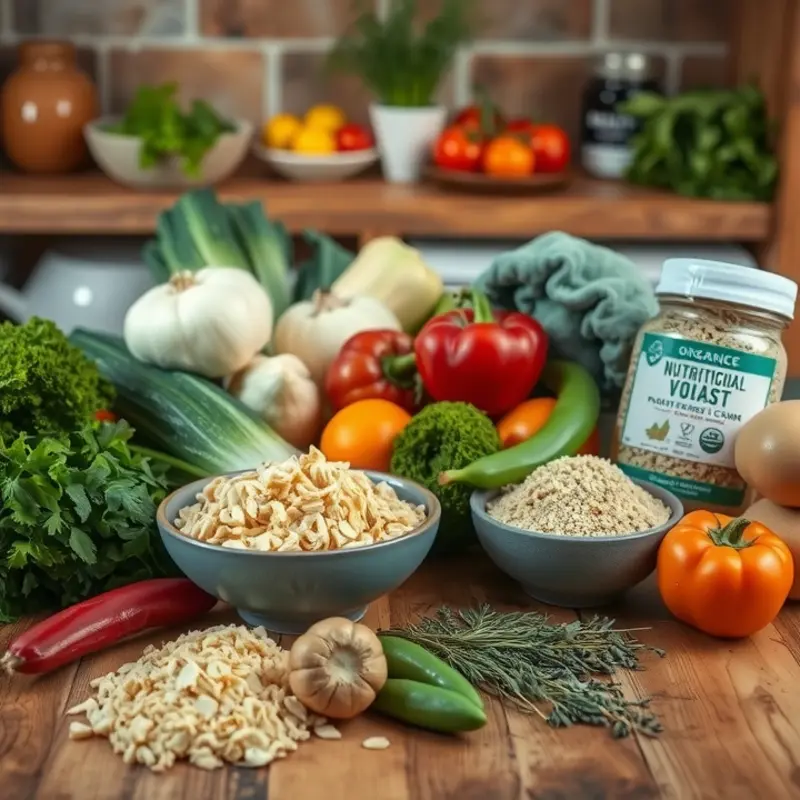Nutritional yeast is gaining popularity in kitchens for its unique flavor and robust nutritional profile. This versatile ingredient serves as a cheese alternative, seasoning, and a source of vitamins, particularly B12, making it ideal for vegan and vegetarian diets. From adding umami to dishes to providing health benefits, nutritional yeast is worth exploring. Discover its uses, substitutions, and cooking tips to elevate your meals in a flavorful, health-conscious way.
What is Nutritional Yeast and Why Use It?

Nutritional yeast, often adored by vegans and non-vegans alike, is a deactivated yeast product typically grown on sugarcane or beet molasses. Its bright yellow flakes or powder can be found in health food stores and supermarkets. Nutritional yeast is packed with essential nutrients, making it a powerhouse addition to any pantry.
One of the primary reasons to incorporate nutritional yeast into your diet is its impressive nutritional profile. A mere two tablespoons generally provide protein ranging from four to eight grams. Moreover, it is usually fortified with vitamin B12, a crucial nutrient often lacking in plant-based diets. Its array of B vitamins aids energy production and brain function.
The savory, cheese-like flavor of nutritional yeast makes it a versatile ingredient in various dishes. It’s a perfect addition for those seeking to reduce dairy intake without sacrificing taste. Sprinkle it on popcorn, pasta, or salads for an umami boost. Stir it into soups and sauces to enhance richness without adding extra fat.
In terms of dietary versatility, nutritional yeast shines. It is gluten-free, soy-free, and typically low in calories, making it suitable for many dietary preferences and restrictions. Its high fiber content supports digestion, while its low glycemic index benefits blood sugar control.
Nutritional yeast is not just about flavor and nutrition—it plays a role in more sustainable eating. As a deactivated yeast, it’s a byproduct of the sugar and molasses industry, which contributes to minimizing food waste. You might want to explore low-waste cooking practices to further enhance your eco-friendly culinary habits; you can learn more about this in our article on low-waste cooking prep.
Incorporating nutritional yeast into daily meals is straightforward. Its cheesy notes can transform a bland dish into a flavorful delight. Vegan macaroni and cheese, creamy sauces, and plant-based spreads all benefit from its unique taste. It’s also an ideal substitute for parmesan cheese in many recipes.
In conclusion, nutritional yeast offers a trifecta of benefits: exceptional nutrition, culinary versatility, and potential dietary support. Whether you follow a plant-based diet or simply want to experiment with new flavors, nutritional yeast offers an easy and nutritious way to enhance meals.
Culinary Applications and Substitutions

Nutritional yeast, with its unique umami flavor, can be a game-changer in various dishes. Incorporating it into your cooking is straightforward and rewarding. Whether you’re looking to enhance a savory sauce or add depth to a plant-based meal, nutritional yeast is versatile enough to adapt to various culinary needs.
Start by sprinkling it on popcorn for a cheesy taste without the dairy. Its nutty flavor profile complements the simplicity of popcorn, creating a satisfying snack that’s both vegan and packed with nutrients. For pasta lovers, nutritional yeast can transform regular tomato sauce into a robust marinara. Just add a tablespoon while simmering and watch your sauce deepen in taste.
If you’re venturing into plant-based cooking, nutritional yeast is invaluable. Use it to create a vegan “cheese” sauce by blending it with soaked cashews, a splash of lemon juice, and garlic powder. This creamy delight works perfectly over nachos, baked potatoes, or as a base for a comforting mac and “cheese.”
Soups and stews benefit significantly from nutritional yeast. For a richer flavor, stir a few teaspoons into your pot during the final cooking stages. This addition balances the dish’s flavors, providing depth even in broth-based recipes. Try it in your next minestrone or vegetable stew for a truly comforting twist.
Nutritional yeast is an excellent substitute for those reducing salt intake. Its savory notes elevate dishes without additional sodium. If you’re keen on exploring more ways to boost flavor without relying on salt, consider reading this guide on flavor boosters.
For a breakfast twist, mix nutritional yeast into scrambled tofu or egg whites. This addition imparts a cheesy richness that transforms a simple dish into a gourmet morning treat. Pair it with spinach and roasted tomatoes for an extra nutritional boost.
Baking enthusiasts can also leverage nutritional yeast. Replace parmesan in savory muffins or scones with nutritional yeast to achieve a similar flavor profile while keeping the recipe plant-based. The yeast flakes add an intriguing taste that can make your baked goods stand out.
Keep your nutritional yeast stored in a cool, dark place inside an airtight container. This ensures it stays fresh and potent, ready to impart its unique character whenever needed.
Incorporating nutritional yeast into your kitchen opens up a world of culinary possibilities. Its adaptability means there’s always a new dish to explore, whether you’re aiming for enhanced flavor complexity or a simple salt substitution.
Final words
Nutritional yeast is not just a health supplement; it’s a delicious, versatile seasoning that can elevate a variety of dishes. With its cheesy flavor and infectious umami, it seamlessly integrates into soups, salads, pastas, and more, bringing robust nutrition alongside taste. As a rich source of B vitamins, it’s especially beneficial for plant-based diets and those looking to enhance their meals without sacrificing flavor. Incorporate nutritional yeast into your cooking repertoire to enjoy its benefits while deliciously enhancing your favorite recipes. Unleash its potential, and explore new culinary horizons today!







